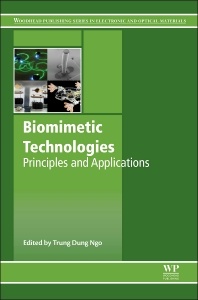Biomimetic Technologies Principles and Applications Woodhead Publishing Series in Electronic and Optical Materials Series
Coordonnateur : Ngo Trung Dung

Biomimetic engineering takes the principles of biological organisms and copies, mimics or adapts these in the design and development of new materials and technologies. Biomimetic Technologies reviews the key materials and processes involved in this groundbreaking field, supporting theoretical background by outlining a range of applications.
Beginning with an overview of the key principles and materials associated with biomimetic technologies in Part One, the book goes on to explore biomimetic sensors in more detail in Part Two, with bio-inspired tactile, hair-based, gas-sensing and sonar systems all reviewed. Biomimetic actuators are then the focus of Part Three, with vision systems, tissue growth and muscles all discussed. Finally, a wide range of applications are investigated in Part Four, where biomimetic technology and artificial intelligence are reviewed for such uses as bio-inspired climbing robots and multi-robot systems, microrobots with CMOS IC neural networks locomotion control, central pattern generators (CPG?s) and biologically inspired antenna arrays.
Part One: Principles and Materials for Biomimetic Technologies 1 Synthesis of molecular biomimetics 2 Bio-inspired fiber composites 3 Solving the bio-machine interface - a synthetic biology approach
Part Two: Bio-inspired sensors 4 Biomimetic tactile sensors 5 Bio-inspired hair-based inertial sensors 6 Bio-inspired gas sensing 7 Bio-inspired engineered sonar systems based on the understanding of bat’s echolocation
Part Three: Biomimetic actuators 8 Conducting interpenetrating polymer networks (IPN) actuators for biomimetic vision system 9 Biomimetic actuation and tissue growth 10 Biomimetic muscle – the sliding friction mechanism (SFM) for dynamic agile animal robots
Part Four: Applications of biomimetic technologies 11 Artificial Intelligence through Symbolic Connectionism – a Biomimetic Rapprochement 15 Biomimetic central pattern generators (CPGs) for robotic applications 12 Implementation of biomimetic central pattern generators on field programmable gate array 13 Bio-inspired climbing robots 14 Locomotion Rhythm Generation Using Pulse-Type Hardware Neural Networks for Quadruped Robots 16 Biologically Inspired Antenna Array Design Using Ormia Modeling
- Includes a solid overview of modern artificial intelligence as background to the principles of biomimetic engineering
- Reviews a selection of key bio-inspired materials and sensors, highlighting their current strengths and future potential
- Features cutting-edge examples of biomimetic technologies employed for a broad range of applications
Date de parution : 07-2015
Ouvrage de 394 p.
15x22.8 cm
Thèmes de Biomimetic Technologies :
Mots-clés :
Biomimetic; bio-inspired; membrane; hydrogels; sensors; actuators; transducers; robotics; structure and characterisation; synthesis; tissue engineering; energy materials; fiber composites; superhydrophobic; anti-fouling coatings; robots; sensor arrays; actuation; control; automation; reconfigurable robots; artificial intelligence


